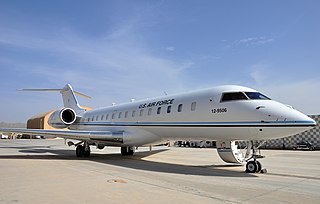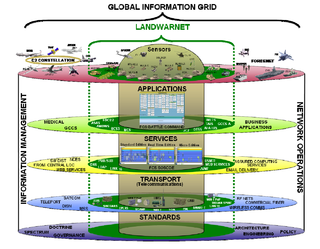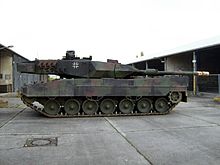
The Defense Information Systems Agency (DISA), known as the Defense Communications Agency (DCA) until 1991, is a United States Department of Defense (DoD) combat support agency composed of military, federal civilians, and contractors. DISA provides information technology (IT) and communications support to the President, Vice President, Secretary of Defense, the military services, the combatant commands, and any individual or system contributing to the defense of the United States.

The United States Joint Forces Command (USJFCOM) was a Unified Combatant Command of the United States Department of Defense. USJFCOM was a functional command that provided specific services to the military. The last commander was Army Gen. Ray Odierno and the Command Senior Enlisted was Marine Sergeant Major Bryan B. Battaglia. As directed by the President to identify opportunities to cut costs and rebalance priorities, Defense Secretary Robert Gates recommended that USJFCOM be disestablished and its essential functions reassigned to other unified combatant commands. Formal disestablishment occurred on 4 August 2011.

The Combat Capabilities Development Command (CCDC) C5ISR Center, formerly the Communications-Electronics RD&E Center (CERDEC), is the United States Army information technologies and integrated systems center. CCDC C5ISR Center is headquartered at Aberdeen Proving Ground in Maryland, with activities at Fort Belvoir in Virginia and Joint Base McGuire-Dix-Lakehurst in New Jersey.

The Global Information Grid (GIG) is a network of information transmission and processing maintained by the United States Department of Defense. More descriptively, it is a worldwide network of information transmission, of associated processes, and of personnel serving to collect, process, safeguard, transmit, and manage this information. It is an all-encompassing communications project of the United States Department of Defense. The GIG makes this immediately available to military personnel, to those responsible for military politics, and for support personnel. It includes all infrastructure, bought or loaned, of communications, electronics, informatics, and security. It is the most visible manifestation of network-centric warfare. It is the combination of technology and human activity that enables warfighters to access information on demand.
Net-Centric Operations Warfare describes how the United States Department of Defense will conduct business operations, warfare, and enterprise management in the future. It is based on the information technology (IT) concept of an assured, dynamic, and shared information environment that provides access to trusted information for all users, based on need, independent of time and place. NCOW is an information-enabled concept of operations that generates increased combat power by networking sensors, decision makers, and shooters. This enables shared awareness, increased speed of command, higher tempo of operations, greater lethality, increased survivability, and a degree of self-synchronization. In essence, network-centric warfare translates information superiority into combat power by effectively linking knowledgeable entities in the battlespace.

NetOps is defined as the operational framework consisting of three essential tasks, Situational Awareness (SA), and Command & Control (C2) that the Commander (CDR) of US Strategic Command (USSTRATCOM), in coordination with DoD and Global NetOps Community, employs to operate, manage and defend the Global Information Grid (GIG) to ensure information superiority for the United States.
John Joseph Garstka is the acting CISO for acquisition and sustainment at the Department of Defense
Battlespace or battle-space is a term used to signify a military strategy which integrates multiple armed forces for the military theatre of operations, including air, information, land, sea, cyber and outer space to achieve military goals. It includes the environment, timeframe and other factors, and conditions that must be understood to successfully apply combat power, protect the force, or complete the mission. This includes enemy and friendly armed forces, infrastructure, weather, terrain, and the electromagnetic spectrum within the operational areas and areas of interest.

Command and control is a "set of organizational and technical attributes and processes ... [that] employs human, physical, and information resources to solve problems and accomplish missions" to achieve the goals of an organization or enterprise, according to a 2015 definition by military scientists Marius Vassiliou, David S. Alberts, and Jonathan R. Agre. The term often refers to a military system.

The Battlefield Airborne Communications Node (BACN) is a United States Air Force (USAF) airborne communications relay and gateway system carried by the unmanned EQ-4B and the manned Bombardier E-11A aircraft. BACN enables real-time information flow across the battlespace between similar and dissimilar tactical data link and voice systems through relay, bridging, and data translation in line-of-sight and beyond-line-of-sight situations. Its ability to translate between dissimilar communications systems allows them to interoperate without modification.
The Command and Control Research Program (CCRP) was an active DoD Research Program from 1994 to 2015. It was housed within the Office of the Assistant Secretary of Defense (NII) and it focused upon (1) improving both the state of the art and the state of the practice of command and control (C2) and (2) enhancing DoD's understanding of the national security implications of the Information Age. It provides "Out of the Box" thinking and explores ways to help DoD take full advantage of Information Age opportunities. The CCRP served as a bridge between the operational and technical communities and enhanced the body of knowledge and research infrastructure needed for future progress.
Thales-Raytheon Systems Company LLC is an aerospace and defence company co-headquartered in Massy, Paris, France and Fullerton, California, United States. It is operated as a 50:50 joint venture between Raytheon Technologies and Thales Group.
David Stephen Alberts is a former American Director of Research for the Office of the Assistant Secretary of Defense for Networks and Information Integration (NII).
Area of responsibility (AOR) is a pre-defined geographic region assigned to Combatant commanders of the Unified Command Plan (UCP), that are used to define an area with specific geographic boundaries where they have the authority to plan and conduct operations; for which a force, or component commander bears a certain responsibility. The term may also be used in other countries worldwide but it originated within the United States Armed Forces. This system is designed to allow a single commander to exercise command and control of all military forces in the AOR, regardless of their branch of service.
LandWarNet (LWN) is the United States Army’s contribution to the Global Information Grid (GIG) that consists of all globally interconnected, end-to-end set of Army information capabilities, associated processes, and personnel for collecting, processing, storing, disseminating, and managing information on demand supporting warfighters, policy makers, and support personnel. It includes all Army and leveraged Department of Defense (DOD)/Joint communications and computing systems and services, software, data security services, and other associated services. LandWarNet exists to enable the warfighter through Mission Command, previously described as Battle Command. Other U.S. service equivalent efforts to LandWarNet include the Navy's "FORCEnet" and the Air Force's "C2 Constellation."

The FCS Network - Brigade Combat Team (BCT) Network consists of five layers that deliver data to forward-deployed Army units.

Battle command (BC) is the discipline of visualizing, describing, directing, and leading forces in operations against a hostile, thinking, and adaptive enemy. Battle command applies leadership to translate decision into actions, by synchronizing forces and warfighting functions in time, space, and purpose, to accomplish missions. Battle command refers both to processes triggered by commanders and executed by soldiers and to the system of systems (SoS) that directly enables those processes.
Project Scorpion is a multinational military modernization program which uses military-run experimentation for acquisition of new armaments. Project Scorpion also tests new military behaviors such as effects-based operations, network-centric warfare, and irregular warfare and civilian-military concepts.
For military strategy, intent is the desired outcome of a military operation. It is a key concept in 21st century military operations and is a vital element to facilitate subordinates' initiative and collaboration and cooperation amongst team members in joint operations.

The Joint Deployable Analysis Team (JDAT) is part of the J6 Directorate of the Joint Chiefs of Staff.








